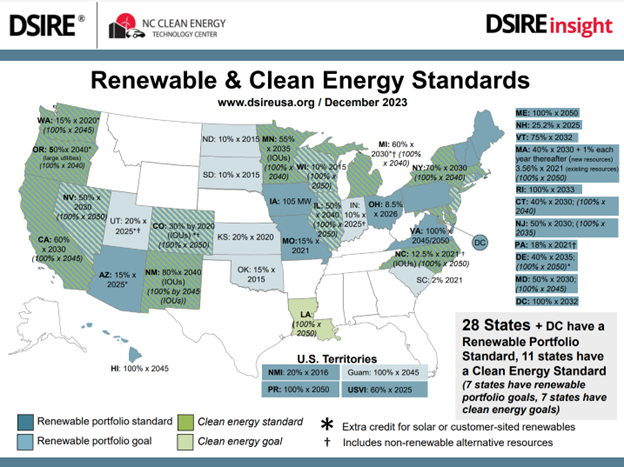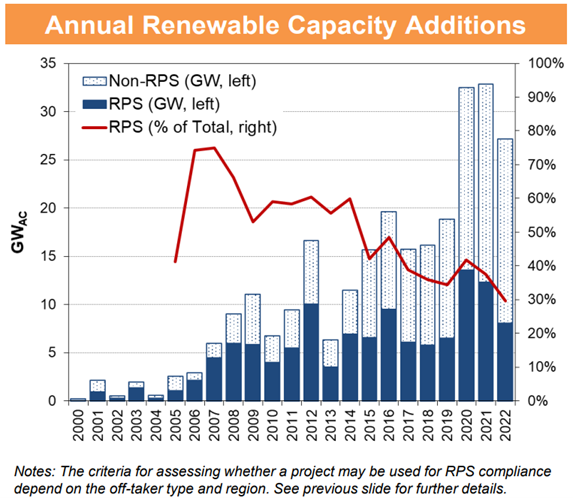Contributions of Policies and Consumer Choice Drivers
In addition to economics, renewable electricity growth is driven by policies and consumer choice.
Policies
Policies like renewable portfolio standards grow demand for renewable electricity by increasing the percentage of renewable electricity that electric service providers, like utilities, must provide to their customers.
Renewable portfolio standards require a certain proportion of the electricity sold by electric service providers be generated using renewable resources by a specific date. For instance, some RPS's (pdf) (e.g., California, Maryland, Nevada, New Jersey, New York, Rhsode Island, etc) renewable portfolio standards require that 50% of the electricity sold by suppliers above a certain size be generated from renewable resources by 2030.

These types of policies exist in over half the U.S. States and the District of Columbia, and each state defines eligible renewable resources differently. Other states have similar policies, such as clean energy standards (where eligible resources may be carbon-free, but not renewable) or renewable goals (where the proportional targets are not requirements).
Consumer Choice
Many options exist for individuals and organizations interested in taking voluntary actions to drive more renewable electricity. Depending on where they live, individuals typically can buy renewable electricity by opting for certain service options offered by their utility or other electricity provider.
Organizations also can purchase these types of products from an electric service provider, as well as other retail products such as renewable energy certificates, or RECs. A number of other options involve purchasing renewables from a specific wind, solar, or other renewable electricity project. More information on these purchasing options is available on the Green Power Supply Options webpage.
Contributions of Policies and Consumer Choice to Renewable Electricity Growth
Policies like renewable portfolio standards (RPS) are a key driver of renewable electricity growth. According to the Lawrence Berkeley National Laboratory, RPS policies constituted 44% of total renewable electricity growth in the U.S. since 2000.

Some effects are difficult to disentangle. While some of the growth attributed to RPS policies may have occurred absent such policies, demand from RPSs may also have contributed to growing markets for renewables and reduced technology and project costs.
Before 2015, in most years, RPSs drove most U.S. renewable capacity additions. More recently, renewable growth has been driven increasingly by consumer choice and economics.

At the same time, consumer choice as a market driver has been on the rise. Between 2010 and 2020, electricity customers proactively choosing renewable electricity quintupled their purchases, such that in 2022 the voluntary market represented about 35% of all non-hydropower renewable generation. Leading this trend has been the growing participation of businesses and the increasing availability and variety of purchasing options, including power purchase agreements (i.e., physical PPAs, virtual PPAs), community choice aggregations, and contracts with utilities.

Policy requirements and consumer choosing to purchase renewable electricity have led to significant demand growth for renewable electricity while contributing different proportions of renewable growth at different times.
